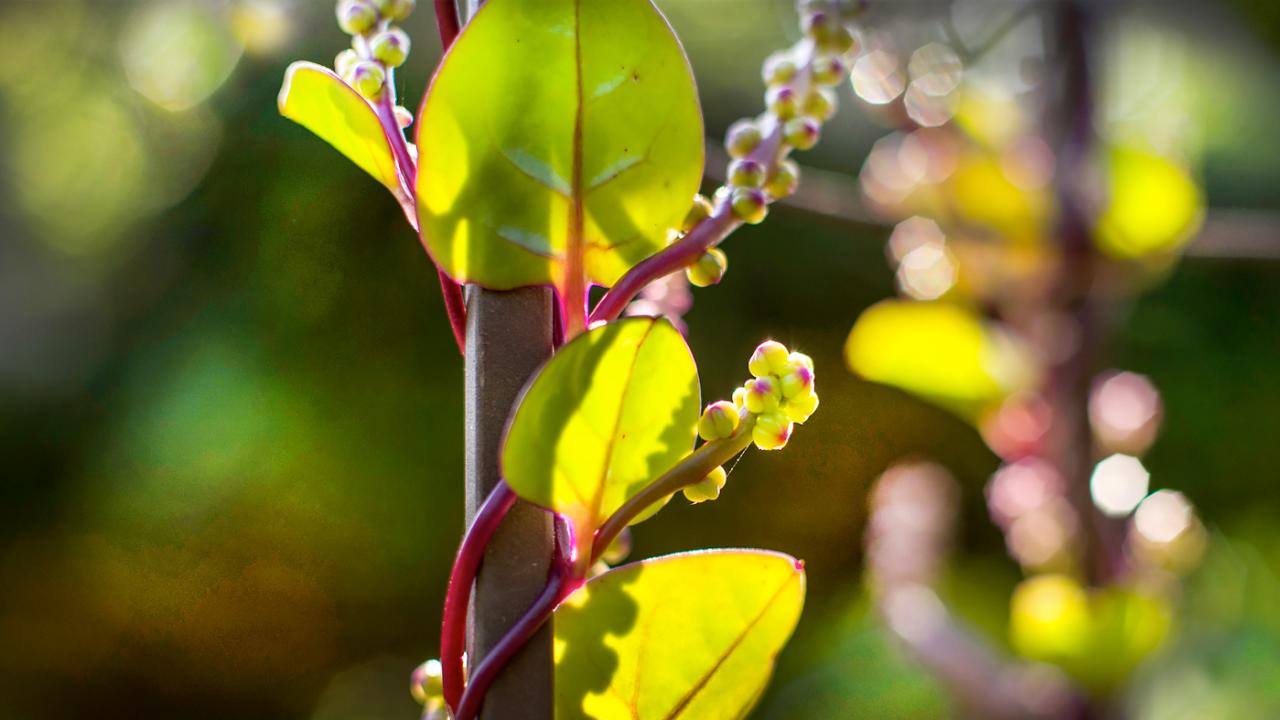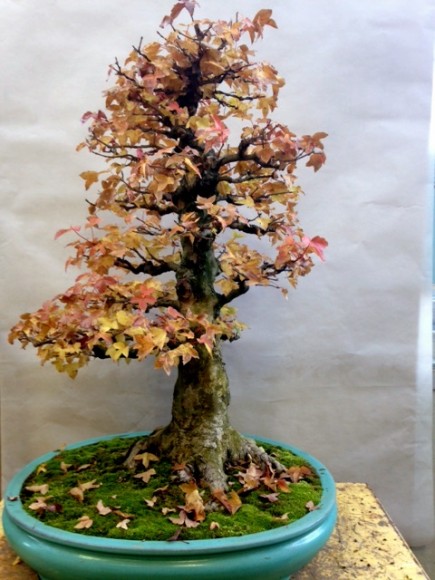

Plants &
Gardening
Garden Stories
Overwintering Your Bonsai
Like so many things in tending bonsai, how you overwinter your trees is specific to the tree species and the region in which you live.

Bonsai in fall color, before being prepped for storage.

The same bonsai prepped for winter storage; tags indicate tasks to do in spring on this tree.
Here in the Chicago area, we need to take special care to protect our trees from cold temperatures and windy conditions. Prior to bringing in your tropical trees and tucking your cold hardy trees away for the winter, there is some work to be done. In this post, we will discuss fall and early winter care that lead into winter storage of tropical, deciduous, and evergreen bonsai.

This far north of the equator, tropical bonsai will need supplemental lighting for the winter months.
To maximize growth and tree health, your tropical bonsai should be outside during the summer months, getting the most of the warm temperatures and full sun. But before the temperatures drop—most tropical bonsai will not tolerate temperatures below 40 to 45 degrees Fahrenheit for any length of time without some damage—it is a good idea to slowly move your trees into lower light conditions. This will prepare your trees for the conditions in your house, and result in less leaf drop when they are moved inside. During this time you should also decrease the feeding of your tropical trees, slowing down the growth.
There are four things to consider when picking a spot in your house for your tropical bonsai.
- Lighting: Even if you have a south-facing window, most trees are going to require supplemental lighting for the winter months.
- Heat: Trees should be in a warm spot in your house, but should never be subject to hot, dry forced air or radiant heating.
- Humidity: Due to the dry nature of our heating, supplemental humidity should be provided. Humidity trays, spraying your trees daily with a spray bottle, and humidifiers are all good ways of increasing the humidity around your trees.
- Watering needs: Tropical trees tend to use less water in the winter. Over watering can cause root rot and a decline in tree health.
The preparation for hardy trees (both deciduous and evergreen) starts long before they are put away for the winter.
In late summer to early fall, you should stop feeding your trees with nitrogen. Nitrogen—the “N” in N.P.K.-based fertilizers— stimulates foliage growth. As fall approaches, we want to start sending energy to the roots, so using a “bloom” fertilizer with higher phosphorous and potassium values (P and K) is important. This will feed the roots and strengthen the tree for winter. It will also provide the tree with the energy for the spring flush. In bonsai, it is important to be proactive rather than reactive. The things we do in the fall determine how trees respond in the spring.

A dusting of snow coats the ground and the outside of the quonset.

Inside, the cold-hardy specimens of the Garden’s Bonsai Collection enjoy being out of the wind and cold temperatures.
The pre-storage work done on your trees is important.
Our winter cleanup on all deciduous trees entails the following:
- Removing all the old foliage from the deciduous trees. This is most often done with tweezers to prevent any damage to the branches and next year’s buds. This step helps to prevent fungal disease forming on those leaves.
- Cleaning the bases of the trunks, and removing moss and weeds from the soil surface. This prevents constant moisture from touching the trunks and allows better air circulation to the roots.
- Performing minor pruning work. The larger cuts will wait until spring when it is safer. All cuts are covered with “cut paste” to seal the wound and prevent disease and damage to the branch.
- Tagging. Finally, each tree receives colored tags that indicate whether it needs repotting in the spring, has wire, needs wire, etc. These indicators are very important when managing about 250 trees!

Foliage is carefully removed by hand before storage.

Moss which has grown over the summer is removed.

Moss has been removed from the trunk pre-storage.

Cover fresh pruning cuts with cut paste.
Evergreen trees and pines get their own pre-storage cleanup.
- Instead of removing leaves, we remove old needles on the pines. This is also done with tweezers, and needles are pulled in the direction in which they grow to prevent damaging the branch.
- Some light pruning is done as well as cleaning the surface of the soil.
- Winter is a great time to do major work on pines like wiring, making big bends, and carving dead wood.

A bonsai pine awaits overwintering preparations.

The same tree after overwintering preparations. It’s ready to be placed with others in the quonset.
We overwinter our cold hardy trees in a climate-controlled quonset. Through a process of heating and venting (if needed), the temperature is maintained at about 34 degrees Fahrenheit, which allows the trees to experience a dormancy period without getting a hard freeze on the roots. This allows us to keep very hardy trees along with those that might like things a little warmer. In the future, we will be adding an additional quonset that maintains temperatures in the mid-40s to accommodate more tree species properly.

Winter is the time for major work on pines like making big bends.
There are many variations of this type of storage that you can implement at home. Creating a space in a garage where you can protect the roots by packing mulch around the tree pots is important. Protecting the trees from wind is also important. High winds will dry out your evergreen foliage and deciduous tree buds, causing damage. Once deciduous trees have dropped their leaves and evergreen trees have experienced a frost, they will have minimal need for light, especially as the temperatures continue to drop. Using snow to cover pots and roots is a good idea. Snow is an excellent insulator, and if temperatures rise enough for it to melt, it will water your trees. (Note: You should never water a tree with a frozen root system—this will damage the roots!)
Proper winter storage will ensure that your trees wake healthy and ready to bud out in spring.

